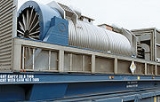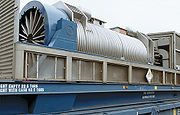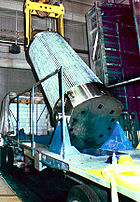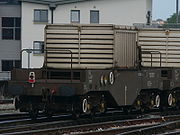
Spent nuclear fuel shipping cask
Encyclopedia

Nuclear fuel
Nuclear fuel is a material that can be 'consumed' by fission or fusion to derive nuclear energy. Nuclear fuels are the most dense sources of energy available...
used in nuclear power plants and research reactors to disposal sites such as the nuclear reprocessing
Nuclear reprocessing
Nuclear reprocessing technology was developed to chemically separate and recover fissionable plutonium from irradiated nuclear fuel. Reprocessing serves multiple purposes, whose relative importance has changed over time. Originally reprocessing was used solely to extract plutonium for producing...
center at COGEMA La Hague site
COGEMA La Hague site
The AREVA NC La Hague site is a nuclear fuel reprocessing plant of AREVA in La Hague on the French Cotentin Peninsula that currently has nearly half of the world's light water reactor spent nuclear fuel reprocessing capacity. It has been in operation since 1976, and has a capacity of about 1700...
. Each shipping container
Shipping container
A shipping container is a container with strength suitable to withstand shipment, storage, and handling. Shipping containers range from large reusable steel boxes used for intermodal shipments to the ubiquitous corrugated boxes...
is designed to maintain its integrity under normal transportation conditions and during hypothetical accident conditions.
United States

United States
The United States of America is a federal constitutional republic comprising fifty states and a federal district...
, the acceptability of the design of each cask is judged against Title 10, Part 71, of the Code of Federal Regulations (other nations' shipping casks, possibly excluding Russia's, are designed and tested to similar standards (International Atomic Energy Agency "Regulations for the Safe Transport of Radioactive Material" No. TS-R-1)). The designs must demonstrate (possibly by computer modelling) protection against radiological release to the environment under all four of the following hypothetical accident conditions, designed to encompass 99% of all accidents:
- A 9 meter (30 ft) free fall on to an unyielding surface
- A puncture test allowing the container to free-fall 1 meter (about 39 inches) onto a steel rod 15 centimeters (about 6 inches) in diameter
- A 30-minute, all-engulfing fire at 800 degrees Celsius (1475 degrees Fahrenheit)
- An 8-hour immersion under 0.9 meter (3 ft) of water.
- Further, an undamaged package must be subjected to a one-hour immersion under 200 meters (655 ft) of water.
In addition, between 1975 and 1977 Sandia National Laboratories
Sandia National Laboratories
The Sandia National Laboratories, managed and operated by the Sandia Corporation , are two major United States Department of Energy research and development national laboratories....
conducted full-scale crash tests on spent nuclear fuel shipping casks. Although the casks were damaged, none would have leaked.
Although the U.S. Department of Transportation (DOT) has the primary responsibility for regulating the safe transport of radioactive materials in the United States, the Nuclear Regulatory Commission
Nuclear Regulatory Commission
The Nuclear Regulatory Commission is an independent agency of the United States government that was established by the Energy Reorganization Act of 1974 from the United States Atomic Energy Commission, and was first opened January 19, 1975...
(NRC) requires that licensees and carriers involved in spent fuel shipments:
- Follow only approved routes;
- Provide armed escorts for heavily populated areas;
- Use immobilization devices;
- Provide monitoring and redundant communications;
- Coordinate with law enforcement agencies before shipments; and
- Notify in advance the NRC and States through which the shipments will pass.
Since 1965, approximately 3,000 shipments of spent nuclear fuel have been transported safely over the U.S.'s highways, waterways, and railroads.
Canada
By comparison there has been limited spent nuclear fuel transport in CanadaCanada
Canada is a North American country consisting of ten provinces and three territories. Located in the northern part of the continent, it extends from the Atlantic Ocean in the east to the Pacific Ocean in the west, and northward into the Arctic Ocean...
. Transportation casks have been designed for truck and rail transport and Canada’s regulatory body granted approval for casks, which may be used for barge shipments as well. Canadian Nuclear Safety Commission
Canadian Nuclear Safety Commission
The Canadian Nuclear Safety Commission , previously known as the Atomic Energy Control Board , is the governmental nuclear power and materials watchdog in Canada...
regulations prohibit the disclosure of location, routing and timing of shipments of nuclear materials, such as spent fuel.
United Kingdom
Over the past 35 years, British Nuclear Fuels plcBNFL
British Nuclear Fuels Limited was a nuclear energy and fuels company owned by the UK Government. It was a former manufacturer and transporter of nuclear fuel , ran reactors, generated and sold electricity, reprocessed and managed spent fuel , and decommissioned nuclear plants and other similar...
(BNFL) and its subsidiary PNTL have conducted over 14,000 cask shipments of SNF worldwide, transporting more than 9,000 tonnes of SNF over 16 million miles via road, rail, and sea without a radiological release. BNF designed, licensed, and currently own and operate a fleet of approximately 170 casks of the Excellox design. BNFL has maintained a fleet of transport casks to ship
SNF for the United Kingdom
United Kingdom
The United Kingdom of Great Britain and Northern IrelandIn the United Kingdom and Dependencies, other languages have been officially recognised as legitimate autochthonous languages under the European Charter for Regional or Minority Languages...
, continental Europe
Europe
Europe is, by convention, one of the world's seven continents. Comprising the westernmost peninsula of Eurasia, Europe is generally 'divided' from Asia to its east by the watershed divides of the Ural and Caucasus Mountains, the Ural River, the Caspian and Black Seas, and the waterways connecting...
, and Japan
Japan
Japan is an island nation in East Asia. Located in the Pacific Ocean, it lies to the east of the Sea of Japan, China, North Korea, South Korea and Russia, stretching from the Sea of Okhotsk in the north to the East China Sea and Taiwan in the south...
for reprocessing
Nuclear reprocessing
Nuclear reprocessing technology was developed to chemically separate and recover fissionable plutonium from irradiated nuclear fuel. Reprocessing serves multiple purposes, whose relative importance has changed over time. Originally reprocessing was used solely to extract plutonium for producing...
.
In the UK a series of public demonstrations were conducted in which spent fuel flasks (loaded with steel bars) were subjected to simulated accident conditions. A randomly selected flask (never used for holding used fuel) from the production line was first dropped from a tower. The flask was dropped in such a way that the weakest part of it would hit the ground first. The lid of the flask was slightly damaged but very little material escaped from the flask. A little water escaped from the flask but it was thought that in a real accident that the escape of radioactivity associated with this water would not be a threat to humans or their environment.
For a second test the same flask was fitted with a new lid, filled again with steel bars and water before a train was driven into it at high speed. The flask survived with only cosmetic damage while the train was destroyed. Although referred to as a test, the actual stresses the flask underwent were well below what they are designed to withstand, as much of the energy from the collision was absorbed by the train and also in moving the flask some distance.
This flask is on display at the training center at Heysham 1 Power Station.
Baltimore train tunnel fire
On July 18, 2001, a freight train carrying hazardous (non-nuclear) materials derailed and caught fire while passing through the Howard Street railroad tunnel in downtown Baltimore, Maryland, United StatesUnited States
The United States of America is a federal constitutional republic comprising fifty states and a federal district...
. The fire burned for 3 days, with temperatures as high as 1000 °C (1800 °F). Since the casks are designed for a 30-minute fire at 800 °C (1475 °F), several reports have been made regarding the inability of the casks to survive a fire similar to the Baltimore one. However, nuclear waste would never be transported together with hazardous (flammable or explosive) materials on the same train or track.
State of Nevada
The State of NevadaNevada
Nevada is a state in the western, mountain west, and southwestern regions of the United States. With an area of and a population of about 2.7 million, it is the 7th-largest and 35th-most populous state. Over two-thirds of Nevada's people live in the Las Vegas metropolitan area, which contains its...
, USA
United States
The United States of America is a federal constitutional republic comprising fifty states and a federal district...
, released a report entitled, "Implications of the Baltimore Rail Tunnel Fire for Full-Scale Testing of Shipping Casks" on February 25, 2003. In the report, they said a hypothetical spent nuclear fuel accident based on the Baltimore fire:
- "Concluded steel-lead-steel cask would have failed after 6.3 hours; monolithic steel cask would have failed after 11-12.5 hours."
- "Contaminated Area: 32 square miles (82 km2)"
- "Latent cancer fatalities: 4,000-28,000 over 50 years (200-1,400 during first year)"
- "Cleanup cost: $13.7 Billion (2001 Dollars)"
National Academy of Sciences
The National Academy of SciencesUnited States National Academy of Sciences
The National Academy of Sciences is a corporation in the United States whose members serve pro bono as "advisers to the nation on science, engineering, and medicine." As a national academy, new members of the organization are elected annually by current members, based on their distinguished and...
, at the request of the State of Nevada, produced a report on July 25, 2003. The report concluded that the following should be done:
- "Need to 3-D model (bolts, seals, etc) more than HI-STAR cask for extreme fire environments."
- "For safety and risk analysis, casks should be physically tested to destruction."
- "NRC should release all thermal calculations; Holtec is withholding allegedly proprietary information."
NRC
The U.S. Nuclear Regulatory Commission released a report on November 2006. It concluded:- The results of this evaluation also strongly indicate that neither spent nuclear fuel (SNF) particles nor fission products would be released from a spent fuel transportation package carrying intact spent fuel involved in a severe tunnel fire such as the Baltimore tunnel fire. None of the three package designs analyzed for the Baltimore tunnel fire scenario (TN-68, HI-STAR 100, and NAC LWT) experienced internal temperatures that would result in rupture of the fuel cladding. Therefore, radioactive material (i.e., SNF particles or fission products) would be retained within the fuel rods.
- There would be no release from the HI-STAR 100, because the inner welded canister remains leak tight. While a release is unlikely, the potential releases calculated for the TN-68 rail package and the NAC LWT truck package indicate that any release of CRUD from either package would be very small - less than an A2 quantity.
Rail security

United Kingdom
The United Kingdom of Great Britain and Northern IrelandIn the United Kingdom and Dependencies, other languages have been officially recognised as legitimate autochthonous languages under the European Charter for Regional or Minority Languages...
newspaper The Daily Mirror
The Daily Mirror
The Daily Mirror is a British national daily tabloid newspaper which was founded in 1903. Twice in its history, from 1985 to 1987, and from 1997 to 2002, the title on its masthead was changed to read simply The Mirror, which is how the paper is often referred to in popular parlance. It had an...
reported that one of their reporters was easily able to plant a fake bomb on a train carrying nuclear waste. The reporter, "exploited security lapses to wander up to the unattended wagons at a North West London depot." The newspaper quoted an expert stating that an attack on containers of radioactive waste could kill over 8,000 people and release a poisonous cloud of up to 100 square miles (259 km²) across Britain. They also reported that the train could have been hijacked by anyone with a basic knowledge of driving trains.
The rail company spokeswoman initially claimed that getting close to the nuclear flasks was not possible. However, after seeing the Mirror's photographic evidence that they did exactly that, she stated, "The entire journey is protected by very stringent security. However, having seen these pictures we will speak with our security people. A full investigation will be carried out."
See also
- Deep geological repositoryDeep geological repositoryA deep geological repository is a nuclear waste repository excavated deep within a stable geologic environment...
- Dry cask storageDry cask storageDry cask storage is a method of storing high-level radioactive waste, such as spent nuclear fuel that has already been cooled in the spent fuel pool for at least one year.. These casks are typically steel cylinders that are either welded or bolted closed. When inside, the fuel rods are surrounded...
- Lists of nuclear disasters and radioactive incidents
- Nuclear flaskNuclear flaskA nuclear flask is a shipping container that is used to transport active nuclear materials between many nuclear power stations in the UK. Each flask weighs more than 50 tonnes, and transports usually not more than 2.5 tonnes of spent nuclear fuel....
- Nuclear fuel cycleNuclear fuel cycleThe nuclear fuel cycle, also called nuclear fuel chain, is the progression of nuclear fuel through a series of differing stages. It consists of steps in the front end, which are the preparation of the fuel, steps in the service period in which the fuel is used during reactor operation, and steps in...
- Spent fuel poolSpent fuel poolSpent fuel pools are storage pools for spent fuel from nuclear reactors. They are typically 40 or more feet deep, with the bottom 14 feet equipped with storage racks designed to hold fuel assemblies removed from the reactor. A reactor's pool is specially designed for the reactor in which the...
External links
- U.S. Transport Council
- Japanese Waste and MOX Shipments From Europe
- Nuclear Regulatory Commission "Safety of Spent Fuel Transportation" (NUREG/BR-0292)
- Nuclear Regulatory Commission Backgrounder on Transportation of Spent Fuel and Radioactive Materials
- List of casks licensed, with links
- Pro-nuclear group's summary
- OCRWM Fact Sheet
- Critique of proposed expanded tests
- Private Fuel Storage, LLC's Q&A
- State of Illinois pamphlet
- Canadian Nuclear Safety Commission
- Canadian Packaging and Transport of Nuclear Substances Regulations
- Fuel Solutions Inc.(BFS), the world’s largest shippers of nuclear materials
- http://www.sandia.gov/tp/SAFE_RAM/MOVIES/RAIL2.AVI
- http://www.sandia.gov/tp/SAFE_RAM/MOVIES/TRUCK2.AVI
- http://www.sandia.gov/tp/SAFE_RAM/MOVIES/BFIRE.AVI

